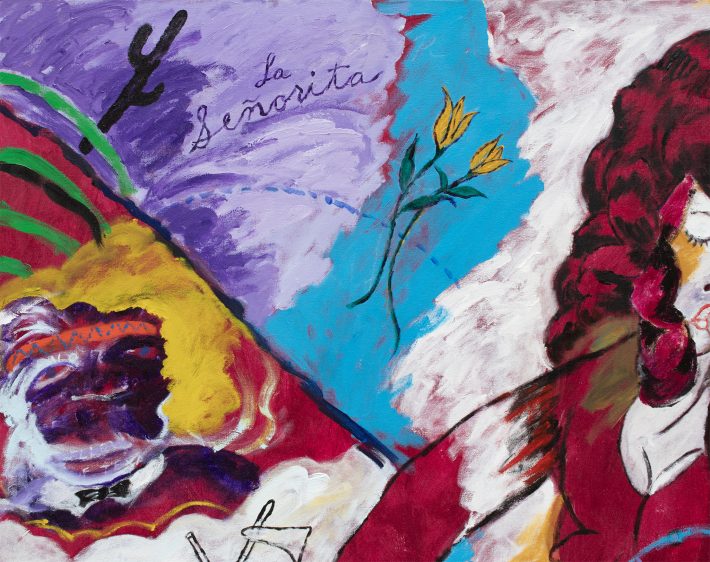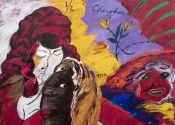
Robert Colescott
Pick a Ninny Rose, 1999
Signed & dated; signed & dated en verso
Acrylic on canvas
84 x 144 inches
Robert Colescott, a significant figure in American art, is celebrated for his satirical and provocative paintings that challenge racial and social stereotypes. His early life was steeped in the arts, growing up in Oakland, California, as the son of two musicians who had migrated from New Orleans1. This early exposure to creativity, along with witnessing the work of his parents’ friend, the artist Sargent Johnson, and Diego Rivera painting a mural at the San Francisco World’s Fair, laid the foundation for his artistic journey1. Despite initial studies in international relations, political science, and economics, Colescott ultimately pursued his passion, receiving his BA and MA in art from the University of California, Berkeley1. His works often reimagine historical narratives and iconic images, infusing them with vibrant colors and a unique blend of humor and critique. This article delves into Colescott’s “Pick a Ninny Rose,” a diptych painted in 1998–1999, exploring its symbolism and the artist’s life and work during his time in the American Southwest.
Colescott in the Southwest
Colescott’s journey to the Southwest began in 1983 when he accepted a position as a visiting professor at the University of Arizona in Tucson. He officially joined the faculty in 1985 and later achieved the distinguished title of Regents’ Professor in 1990, a testament to his significant contributions to the art department2. It was during this period in 1985 that he embarked on a series titled “The Knowledge of the Past is the Key to the Future,” inspired by the philosopher George Santayana’s famous dictum3. This series, consisting of large-scale compositions based on popular narratives from American history, reflected Colescott’s ongoing exploration of the complexities of race, identity, and historical representation.
During his time in the Southwest, Colescott continued to create ever more complex visual commentaries on colonialism, history, and global issues4. His later paintings, including “Pick a Ninny Rose,” saw a gradual shift towards lyrical abstract passages and swirling vignettes that retained narratives of human injustices and foibles4. This evolution in style, with abstraction becoming increasingly prominent, was further influenced by his experience with Parkinson’s syndrome in the early 2000s6.
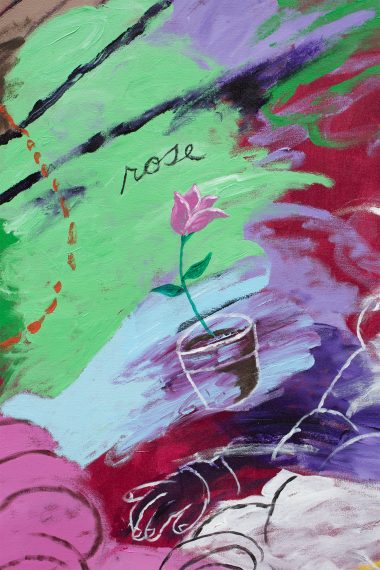 Colescott’s work in the Southwest was undoubtedly influenced by the region’s unique cultural and historical context. He drew inspiration from the dynamics of race and gender in American society, particularly within the Southwestern landscape7. One significant influence during this period was his mentorship of the Chicano artist Vincent Valdez8. This collaboration likely provided Colescott with a deeper understanding of the Chicano experience and the complexities of identity within the Southwest, further enriching his artistic perspective.
Colescott’s work in the Southwest was undoubtedly influenced by the region’s unique cultural and historical context. He drew inspiration from the dynamics of race and gender in American society, particularly within the Southwestern landscape7. One significant influence during this period was his mentorship of the Chicano artist Vincent Valdez8. This collaboration likely provided Colescott with a deeper understanding of the Chicano experience and the complexities of identity within the Southwest, further enriching his artistic perspective.
It is important to note Colescott’s transformative experience in Egypt before his move to the Southwest. In the 1960s, he lived and worked in Egypt, studying and teaching at the American Research Center in Cairo1. This immersion in a culture where people of color held positions of power, including the president, profoundly impacted his artistic vision and his focus on race as a central theme in his work1.
“Pick a Ninny Rose”: Symbolism and Context
“Pick a Ninny Rose” is a striking example of Colescott’s artistic style. The painting itself is a diptych, with two panels that work together to create a complex and layered narrative. Colescott’s use of vibrant colors and distorted figures immediately captures the viewer’s attention, creating a sense of unease and discomfort that encourages deeper engagement with the work.
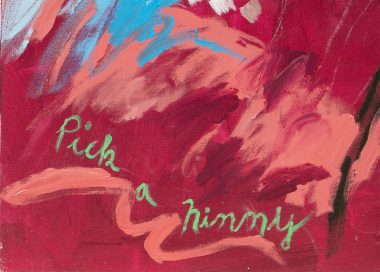 The title itself is a play on words, referencing the children’s rhyme “Ring Around the Rosie” while also alluding to the derogatory term “pickaninny.”9 This word, with its roots in the Portuguese word pequenino (meaning small child) and its historical usage in the United States and other Commonwealth countries, carries a heavy historical and cultural baggage9. It represents the dehumanization and stereotyping of Black children, often depicted in popular culture with exaggerated features, engaged in stereotypical activities, and portrayed as objects of ridicule or pity10.
The title itself is a play on words, referencing the children’s rhyme “Ring Around the Rosie” while also alluding to the derogatory term “pickaninny.”9 This word, with its roots in the Portuguese word pequenino (meaning small child) and its historical usage in the United States and other Commonwealth countries, carries a heavy historical and cultural baggage9. It represents the dehumanization and stereotyping of Black children, often depicted in popular culture with exaggerated features, engaged in stereotypical activities, and portrayed as objects of ridicule or pity10.
Colescott’s use of the “pickaninny” caricature in “Pick a Ninny Rose” is not an endorsement of this racist imagery but rather a subversive reappropriation. By placing this loaded term within the context of his painting, he forces viewers to confront the uncomfortable realities of racism and its impact on Black identity. He challenges the historical meaning of the caricature, exposing the underlying racism it represents and prompting critical reflection on the ways in which Black children have been depicted throughout history.
Furthermore, “Pick a Ninny Rose” reflects Colescott’s artistic philosophy of recycling imagery “from negative to positive.”11 He takes a derogatory term and recontextualizes it within a larger narrative that challenges its original meaning and asserts the agency and complexity of Black identity. This approach aligns with his views on appropriation, which he considered a “dead issue” in the late 1990s12. He believed that artists should engage with and reimagine existing imagery to create new meanings and challenge established narratives.
The historical and cultural context of “Pick a Ninny Rose” is crucial to understanding its significance. The painting was created in the late 1990s, a time of increased awareness and discussion surrounding racial issues in the United States. Colescott’s work, with its bold and unapologetic approach to addressing these issues, contributed to the ongoing dialogue and challenged viewers to reconsider their own perceptions and biases.
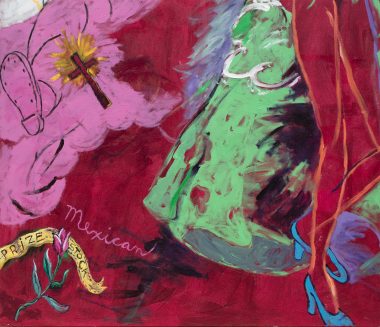 Robert Colescott was known for inserting art historical references in his work. In this painting, you will find nods to works like Philip Guston’s 1968 painting “Shoes” along with a race-changed Picasso figure, Felix the Cat, and a black-face Micky Mouse, which highlights the character’s roots in blackface minstrelsy and vaudeville.
Robert Colescott was known for inserting art historical references in his work. In this painting, you will find nods to works like Philip Guston’s 1968 painting “Shoes” along with a race-changed Picasso figure, Felix the Cat, and a black-face Micky Mouse, which highlights the character’s roots in blackface minstrelsy and vaudeville.
Moreover, “Pick a Ninny Rose” connects to both Colescott’s earlier and later works. It builds upon his earlier explorations of racial stereotypes and historical narratives while also foreshadowing the increasing abstraction and dream-like quality that would characterize his later paintings, particularly those influenced by Parkinson’s syndrome6. The painting’s form, gesture, fully saturated color, and blank space come together to create a work that is both dream-like and nightmarish, reflecting the complexities of race and identity in a way that is both unsettling and compelling6.
Contemporary Works
 To further understand Colescott’s artistic output during the period of “Pick a Ninny Rose,” it’s essential to examine other works he created around the same time. In 1996, he painted “Dagwood Bumstead,” a satirical take on the iconic comic strip character, depicting him about to indulge in his signature sandwich while his wife Blondie looks on disapprovingly13. This work, like “Pick a Ninny Rose,” demonstrates Colescott’s ability to engage with popular culture and infuse it with social commentary.
To further understand Colescott’s artistic output during the period of “Pick a Ninny Rose,” it’s essential to examine other works he created around the same time. In 1996, he painted “Dagwood Bumstead,” a satirical take on the iconic comic strip character, depicting him about to indulge in his signature sandwich while his wife Blondie looks on disapprovingly13. This work, like “Pick a Ninny Rose,” demonstrates Colescott’s ability to engage with popular culture and infuse it with social commentary.
Another notable work from this period is “Signs and Monuments (Kilroy)” (1999)13. This painting incorporates personal references, such as the “Kilroy was here” graffiti tag from Colescott’s time in the Army during World War II, alongside broader allusions to capitalism and his experiences in Egypt. The inclusion of the Sphinx and pyramids reflects the lasting impact of his time in Cairo on his artistic vision13.
These contemporary works, alongside “Pick a Ninny Rose,” showcase the range and depth of Colescott’s artistic explorations during this period. They demonstrate his ability to weave together personal experiences, social commentary, and art historical references into complex and thought-provoking narratives.
Colescott’s Artistic Legacy
 Robert Colescott’s artistic legacy is marked by his unique ability to merge social commentary with artistic expression. His paintings, while often humorous and satirical, delve into complex themes of race, identity, and history. “Pick a Ninny Rose” stands as a powerful example of his artistic vision, a work that confronts viewers with uncomfortable truths while simultaneously celebrating the resilience and strength of Black identity.
Robert Colescott’s artistic legacy is marked by his unique ability to merge social commentary with artistic expression. His paintings, while often humorous and satirical, delve into complex themes of race, identity, and history. “Pick a Ninny Rose” stands as a powerful example of his artistic vision, a work that confronts viewers with uncomfortable truths while simultaneously celebrating the resilience and strength of Black identity.
Colescott’s work has been exhibited in numerous retrospectives and exhibitions throughout his career, further solidifying his position as a significant figure in American art. These exhibitions have not only showcased his work but also provided a platform for critical engagement with his ideas and their impact on the art world.
|
Exhibition Title |
Year |
Location |
Key Highlights |
|---|---|---|---|
|
Robert Colescott: A Retrospective |
1989 |
New Museum, New York |
Showcased works from 1975 to 1986, highlighting his early exploration of race and social satire14. |
|
Recent Paintings, 1987–1997 |
1998 |
Walker Art Center, Minneapolis |
Focused on his later works, showcasing the evolution of his style and his continued engagement with social and political themes15. |
|
Art and Race Matters: The Career of Robert Colescott |
2019 |
Contemporary Arts Center, Cincinnati |
A comprehensive retrospective spanning his entire career, including never-before-seen early works and highlighting his significant contribution to American art16. This exhibition was awarded the Sotheby’s Prize for its curatorial excellence and groundbreaking approach to exploring Colescott’s work11. |
The “Art and Race Matters” retrospective, in particular, has had a profound impact on the understanding and appreciation of Colescott’s work. It garnered critical acclaim for its comprehensive approach and its timely exploration of race and identity in American art5. The exhibition solidified Colescott’s position as a major figure in American art and sparked renewed interest in his work among scholars, critics, and the public.
In 1997, Colescott achieved a significant milestone in his career by representing the United States with a solo exhibition in the American Pavilion at the Venice Biennale4. This prestigious honor brought him international recognition and further cemented his place in the art world.
Conclusion
Robert Colescott’s “Pick a Ninny Rose” is a powerful and thought-provoking work that encapsulates the artist’s commitment to social commentary and artistic innovation. His time in the American Southwest, following his transformative experience in Egypt, profoundly influenced his artistic vision, providing a unique context for his exploration of race, identity, and history. Through his satirical and reappropriated imagery, Colescott challenges viewers to confront uncomfortable truths and engage in critical reflection on the complexities of American society.
Colescott’s legacy extends beyond his individual works. He paved the way for contemporary artists to engage with complex social and political issues through their art, inspiring them to challenge the status quo and spark dialogue. His bold and unapologetic approach to addressing race and identity continues to resonate with audiences today, making his work as relevant and necessary as ever in our current social and political climate.
Works Cited
- Robert Colescott – Figuring History – Seattle Art Museum,, https://figuringhistory.site.seattleartmuseum.org/robert-colescott/
- Robert Colescott – Wikipedia, https://en.wikipedia.org/wiki/Robert_Colescott
- Selected Works – Robert Colescott (1925-2009) – Artists – Michael Rosenfeld Art, https://www.michaelrosenfeldart.com/artists/robert-colescott-1925-2009
- “Robert Colescott (1925-2009),” art ltd. – Arthur Roger Gallery, https://arthurrogergallery.com/2009/09/robert-colescott-1925-2009-art-ltd/
- How Robert Colescott used art history to force viewers to confront their prejudices, https://www.theartnewspaper.com/2022/04/01/robert-colescott-art-and-race-matters-retrospective-chicago
- PRESENTATION: Robert Colescott-Art and Race Matters – Dreamideamachine, http://www.dreamideamachine.com/?p=79406
- Contemporary Art Gallery | Jan 01, 2024 through Nov 30, 2024 | The University of Arizona Museum of Art, https://artmuseum.arizona.edu/see-do/exhibitions/2024/01/01/contemporary-art-gallery
- Southwest ‘Casta’ Paintings Spotlight Race, Popular Culture – VOA, https://www.voanews.com/a/southwest-casta-paintings-spotlight-race-popular-culture/4294782.html
- Pickaninny – Wikipedia, https://en.wikipedia.org/wiki/Pickaninny
- The Picaninny Caricature – Anti-black Imagery – Jim Crow Museum, https://jimcrowmuseum.ferris.edu/antiblack/picaninny/homepage.htm
- Art and Race Matters: The Career of Robert Colescott – Contemporary Arts Center, https://www.contemporaryartscenter.org/files/learn/colescott.pdf
- Figuring History: Robert Colescott, Kerry James Marshall, Mickalene Thomas – Riot Material, https://www.riotmaterial.com/figuring-history/
- Robert Colescott – Exhibitions – George Adams Gallery, https://www.georgeadamsgallery.com/exhibitions/robert-colescott
- Robert Colescott: A Retrospective – Exhibitions – New Museum Digital Archive, https://archive.newmuseum.org/exhibitions/177
- Robert Colescott’s Art For Sale, Exhibitions & Biography | Ocula Artist, https://ocula.com/artists/robert-colescott/
- Art and Race Matters: The Career of Robert Colescott, https://www.contemporaryartscenter.org/experience/exhibitions/2019/09/robert-colescott
